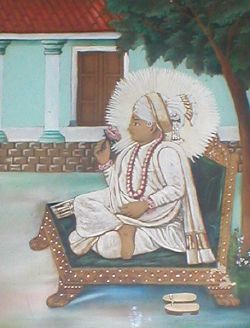Difference between revisions of "Template: Featured article 04 9" - New World Encyclopedia
(Daily featured article from 2008 43) |
|||
| Line 1: | Line 1: | ||
{{Main page article box| | {{Main page article box| | ||
type=Featured| | type=Featured| | ||
| − | title= | + | title=Swaminarayan| |
| − | image_name= | + | image_name=Sahajanand Swami.jpg| |
| − | image_desc= | + | image_desc=Swaminarayan under a [[Neem]] tree in [[Gadhada]]| |
| − | text=''' | + | text='''Swaminarayan''' ({{lang-gu|સ્વામિનારાયણ}}, [[Devanagari]]: स्वामीनारायण, [[IAST]]: ''{{IAST|Svāmīnārāyaṇa}}'') (April 3, 1781 – June 1, 1830), also known as '''Sahajanand Swami''', is the founder of the Swaminaryan Sampraday, a vibrant expression of contemporary [[Hinduism]], in the [[Vaishnavism|Vaisnavite]] tradition. |
| − | In | + | Swaminarayan was born '''Ghanshyam Pande''' in [[Chhapaiya]], [[Uttar Pradesh]], [[India]] in 1781. In 1792, he began a seven year pilgrimage across India, adopting the name ''Nilkanth Varni''. He settled in the state of [[Gujarat]] around 1799. In 1800, he was initiated into the [[Uddhav Sampraday]] by his guru, [[Ramanand Swami]], and was given the name ''Sahajanand Swami''. In 1802, his guru handed over the leadership of the Uddhav Sampraday to him before his death. Soon after the death of his Guru Ramanand Swami, Sahajanand Swami held a gathering and taught the [[Swaminarayan mantra]]. From this point onwards, he was known as ''Swaminarayan'' and within the sect, he is regarded as an incarnation of [[God]], [[Purushottama]], or is venerated as an incarnation of Narayana from the [[Nara-Narayana]] deity pair by his followers. The Uddhav Sampraday became known as the ''[[Swaminarayan Sampraday]]''. |
| + | |||
| + | Swaminarayan built six temples in his lifetime and appointed 500 [[paramhansa]]s to spread his philosophy. In 1826, Swaminarayan wrote the ''[[Shikshapatri]]'', a book of social principles. He died on June 1, 1830 and was [[cremation|cremated]] according to Hindu rites in [[Gadhada]], [[Gujarat]]. Before his death, Swaminarayan appointed his adopted nephews as [[acharya]]s to head the two primary dioceses of the Swaminarayan Sampraday. | ||
| + | |||
| + | Importantly, Swaminarayan did a great deal to advance reforms for women and the poor, performing ''[[yajna]]s'' or fire sacrifices on a large scale as well as performing miracles. Swaminarayan had an estimated 1.8 million followers when he died. His current following is estimated between 5 and 20 million.}} | ||
Revision as of 15:52, 27 March 2018
Swaminarayan was born Ghanshyam Pande in Chhapaiya, Uttar Pradesh, India in 1781. In 1792, he began a seven year pilgrimage across India, adopting the name Nilkanth Varni. He settled in the state of Gujarat around 1799. In 1800, he was initiated into the Uddhav Sampraday by his guru, Ramanand Swami, and was given the name Sahajanand Swami. In 1802, his guru handed over the leadership of the Uddhav Sampraday to him before his death. Soon after the death of his Guru Ramanand Swami, Sahajanand Swami held a gathering and taught the Swaminarayan mantra. From this point onwards, he was known as Swaminarayan and within the sect, he is regarded as an incarnation of God, Purushottama, or is venerated as an incarnation of Narayana from the Nara-Narayana deity pair by his followers. The Uddhav Sampraday became known as the Swaminarayan Sampraday.
Swaminarayan built six temples in his lifetime and appointed 500 paramhansas to spread his philosophy. In 1826, Swaminarayan wrote the Shikshapatri, a book of social principles. He died on June 1, 1830 and was cremated according to Hindu rites in Gadhada, Gujarat. Before his death, Swaminarayan appointed his adopted nephews as acharyas to head the two primary dioceses of the Swaminarayan Sampraday.
Importantly, Swaminarayan did a great deal to advance reforms for women and the poor, performing yajnas or fire sacrifices on a large scale as well as performing miracles. Swaminarayan had an estimated 1.8 million followers when he died. His current following is estimated between 5 and 20 million.